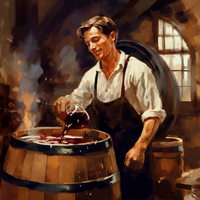The Art of Fortified Wines: A Quick Guide
Posted by Matteo Lahm on 14th Mar 2025
Fortified wines have long captivated the palates of wine enthusiasts, weaving a tapestry of rich and robust flavors that set them apart from other varieties. This article aims to paint a vivid picture of the production process of fortified wines, as well as the diverse styles and characteristics that make them a true masterpiece. By delving into the history, production techniques, and sensory attributes of fortified wines, this article will guide you through the basics of how to make your own fortified wine and some stylistic overviews.
Fortified wines, also known as "liqueur wines" or "vin de liqueur," are wines that have been elevated with the addition of a distilled spirit, typically brandy. This process not only boosts the alcohol content of the wine but also infuses it with unique flavors and characteristics that are highly sought after by wine enthusiasts. Some of the most renowned fortified wines include Port, Sherry, Madeira, and Marsala, each with its own distinct production methods and flavor profiles.
The art of fortifying wines can be traced back to ancient times, with evidence suggesting that the Greeks and Romans were among the first to dabble in this technique. The primary purpose of fortification was to preserve the wine during lengthy sea voyages, as the added alcohol helped to ward off spoilage and oxidation. Over time, fortified wines gained popularity for their unique flavors and became a staple in many European countries, particularly in regions with a strong maritime tradition.

The process of crafting a fortified wine is a harmonious blend of art and science, striking a delicate balance between tradition and innovation. Once the desired level of fermentation has been reached, you will introduce a distilled spirit, typically grape brandy, to the fermenting wine. This halts the fermentation process by vanquishing the yeast and leaves residual sugar in the wine, resulting in a sweeter, higher-alcohol elixir. If you noticed that the process does not include potassium sorbate, good eye. While you can use it, it is not necessary. Raising the ABV to near 20% during fortification will successfully kill the yeast.
However, you also have the option to let the wine ferment completely dry before fortifying it. This approach allows the yeast to consume all the sugar, resulting in a dry wine with a higher alcohol content. Once the fermentation is complete, the distilled spirit is added to increase the overall alcohol content and enhance the wine's flavor profile. This method is particularly useful for creating fortified wines with a drier, more complex character, as it allows you to have greater control over the sweetness and flavor nuances.
Ultimately, the choice of when to fortify the wine depends on the winemaker's desired outcome and the specific style of fortified wine being produced. Some styles, such as certain types of Sherry, may benefit from a drier base wine, while others, like Port, are typically characterized by their inherent sweetness. By understanding the intricacies of the fortification process and the various options available, winemakers can skillfully craft fortified wines that cater to a diverse range of palates and preferences.
Fortified wines are typically aged in oak barrels, which bestow additional flavors and complexity to the wine. The length of aging can vary greatly depending on the style of fortified wine being produced, with some wines being aged for just a few months, while others may be aged for several decades. If you don't have a barrel, oak cubes or spirals in a carboy will suffice just fine.
There are several distinct styles of fortified wines, each with its own unique production methods and flavor profiles. Some of the most popular styles include:

- Port: Hailing from Portugal, Port is a sweet, rich, and full-bodied fortified wine made primarily from red grapes. It is typically aged in oak barrels and can be found in a variety of styles, including Ruby, Tawny, and Vintage.
- Sherry: Born in the Jerez region of Spain, Sherry is a diverse category of fortified wines that can range from dry and crisp to sweet and nutty. The production process involves a unique aging system known as the "solera," which involves blending wines from multiple vintages to achieve a consistent flavor profile.
- Madeira: A product of the Madeira Islands of Portugal, Madeira is a fortified wine celebrated for its distinctive caramelized and oxidative flavors. The wine is intentionally exposed to heat and oxygen during the aging process, resulting in a complex and long-lasting wine that can be savored for decades.
- Marsala: A fortified wine from Sicily, Marsala is typically amber in color and can range from dry to sweet. It is often used in cooking, particularly in Italian cuisine, but can also be enjoyed as a sipping wine.
Fortified wines offer a unique and diverse palette of flavors and styles that are sure to enchant any wine enthusiast. By understanding the production process and the various characteristics of each style, you can better appreciate the complexity and craftsmanship that goes into creating these exceptional wines. Whether enjoyed as an aperitif, a dessert wine, or a key ingredient in a culinary masterpiece, fortified wines are a testament to the rich history and enduring appeal of this timeless winemaking tradition.

